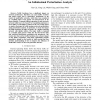Free Online Productivity Tools
i2Speak
i2Symbol
i2OCR
iTex2Img
iWeb2Print
iWeb2Shot
i2Type
iPdf2Split
iPdf2Merge
i2Bopomofo
i2Arabic
i2Style
i2Image
i2PDF
iLatex2Rtf
Sci2ools
CDC
2009
IEEE
2009
IEEE
Impact of arrival burstiness on queue length: An infinitesimal perturbation analysis
Traffic burstiness has a significant impact on network performance. Burstiness can cause buffer overflows and packet drops and is particularly problematic in the context of small-buffer networks, which have been considered as a building block of the optical core infrastructure in the future Internet. To permit efficient operation of such networks, network traffic has to be "paced" by transmitting end-hosts or access links to avoid buffer overflows in the core. In this paper, we analyze the impact of traffic pacing on network performance using perturbation analysis. In particular, we study the impact of traffic burstiness on buffer occupancy of a tandem queueing network with infinite buffers. The input traffic is modeled as a marked point process which has the inter-arrival time and workload distributions containing scale parameters. Our results show that arrival traffic burstiness has a linear impact on the buffer occupancies. This linear relationship provides quantitative in...
| Added | 12 Aug 2010 |
| Updated | 12 Aug 2010 |
| Type | Conference |
| Year | 2009 |
| Where | CDC |
| Authors | Yan Cai, Yong Liu, Weibo Gong, Tilman Wolf |
Comments (0)

